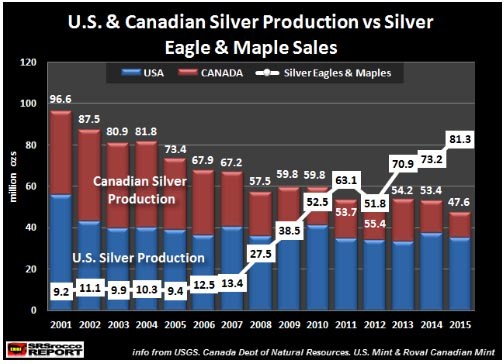Historically, silver has largely been regarded as a safe haven in times of turmoil and unrest and an effective hedge against the effects of inflation. However, despite some significant turmoil within world financial markets there has been only a negligible impact on the precious metals prices which has seen it rally from the $15.86 an ounce mark to trade just above the $20.00 handle. Subsequently, given the ongoing easing around the world and the linkage between expansion in the money supply and inflation, it is surprising that we are not seeing sharply higher silver prices.
Firstly, it’s important to note that Silver prices have been on the rise when you consider prices for the physical metal. In fact, demand for the actual metal has skyrocketed and has clearly been outstripping supply over the past few years. Subsequently, in many cases consumers have been facing delays or difficulty in obtaining reasonable quantities of tradable silver bullion. However, this level of increased demand has seemingly been unable to flow into the silver derivative market.
The reality is that there is little likelihood that you will see the divide between the physical and derivative markets narrow anytime soon. In particular, the COMEX market for silver derivatives is anything but fair with the big banks issuing Silver derivatives at will in an attempt to keep the price below their bulwark around the 50DMA line at $20.50.
What has largely become known as the “Waterfall” effect, involves the larger financial institutions floating as much paper as needed to ensure a depressed market and some sharp declines in prices. This is readily apparent when you realise that the inventory of physical metals within the COMEX vault available for delivery has been declining rapidly over the past few months which also coincides
with a sharp rise in the amount of silver derivatives flying around. In fact, JP Morgan has been one of the largest issuers of paper on the silver market and many of us are left questioning just how much of that silver is actually available for delivery in “physical” form.
Non-Inflation Adjusted Historical Silver Prices
In addition, there has also been a historic connection between the M2 Money Supply figures and the Gold and Silver price. However, since late 2012 there has been a supposed “uncoupling” of these figures which some analysts point to as evidence that the relevance of precious metals are waning in the modern world. However, they miss the linkage between inflation and silver and the fact that the former has largely been absent in recent years (at least persistent inflation). Subsequently, the assertion that the relationship between the money supply and precious metals prices no longer exists is intellectually dishonest at best.
Ultimately, silver will need to move to a significantly higher valuation to match not only the increase in physical demand for the commodity but also the expansion in the underlying US money supply. It’s clear that the large financial institutions will resist this move by attempting to oversupply the market with additional derivatives but this must reach a tipping point at some stage. When that happens, watch out because silver prices will roar and may very well catch many of these institutions asleep at the switch.
Risk Warning: Any form of trading or investment carries a high level of risk to your capital and you should only trade with money you can afford to lose. The information and strategies contained herein may not be suitable for all investors, so please ensure that you fully understand the risks involved and you are advised to seek independent advice from a registered financial advisor. The advice on this website is general in nature and does not take into account your objectives, financial situation or needs. You should consider whether the advice is suitable for you and your personal circumstances. The information in this article is not intended for residents of New Zealand and use by any person in any country or jurisdiction where such distribution or use would be contrary to local law or regulation. Knight Review is not a registered financial advisor and in no way intends to provide specific advice to you in any form whatsoever and provide no financial products or services for sale. As always, please take the time to consult with a registered financial advisor in your jurisdiction for a consideration of your specific circumstances.
Recommended Content
Editors’ Picks
EUR/USD climbs to 10-day highs above 1.0700

EUR/USD gained traction and rose to its highest level in over a week above 1.0700 in the American session on Tuesday. The renewed US Dollar weakness following the disappointing PMI data helps the pair stretch higher.
GBP/USD extends recovery beyond 1.2400 on broad USD weakness

GBP/USD gathered bullish momentum and extended its daily rebound toward 1.2450 in the second half of the day. The US Dollar came under heavy selling pressure after weaker-than-forecast PMI data and fueled the pair's rally.
Gold rebounds to $2,320 as US yields turn south

Gold reversed its direction and rose to the $2,320 area, erasing a large portion of its daily losses in the process. The benchmark 10-year US Treasury bond yield stays in the red below 4.6% following the weak US PMI data and supports XAU/USD.
Here’s why Ondo price hit new ATH amid bearish market outlook Premium

Ondo price shows no signs of slowing down after setting up an all-time high (ATH) at $1.05 on March 31. This development is likely to be followed by a correction and ATH but not necessarily in that order.
Germany’s economic come back

Germany is the sick man of Europe no more. Thanks to its service sector, it now appears that it will exit recession, and the economic future could be bright. The PMI data for April surprised on the upside for Germany, led by the service sector.

